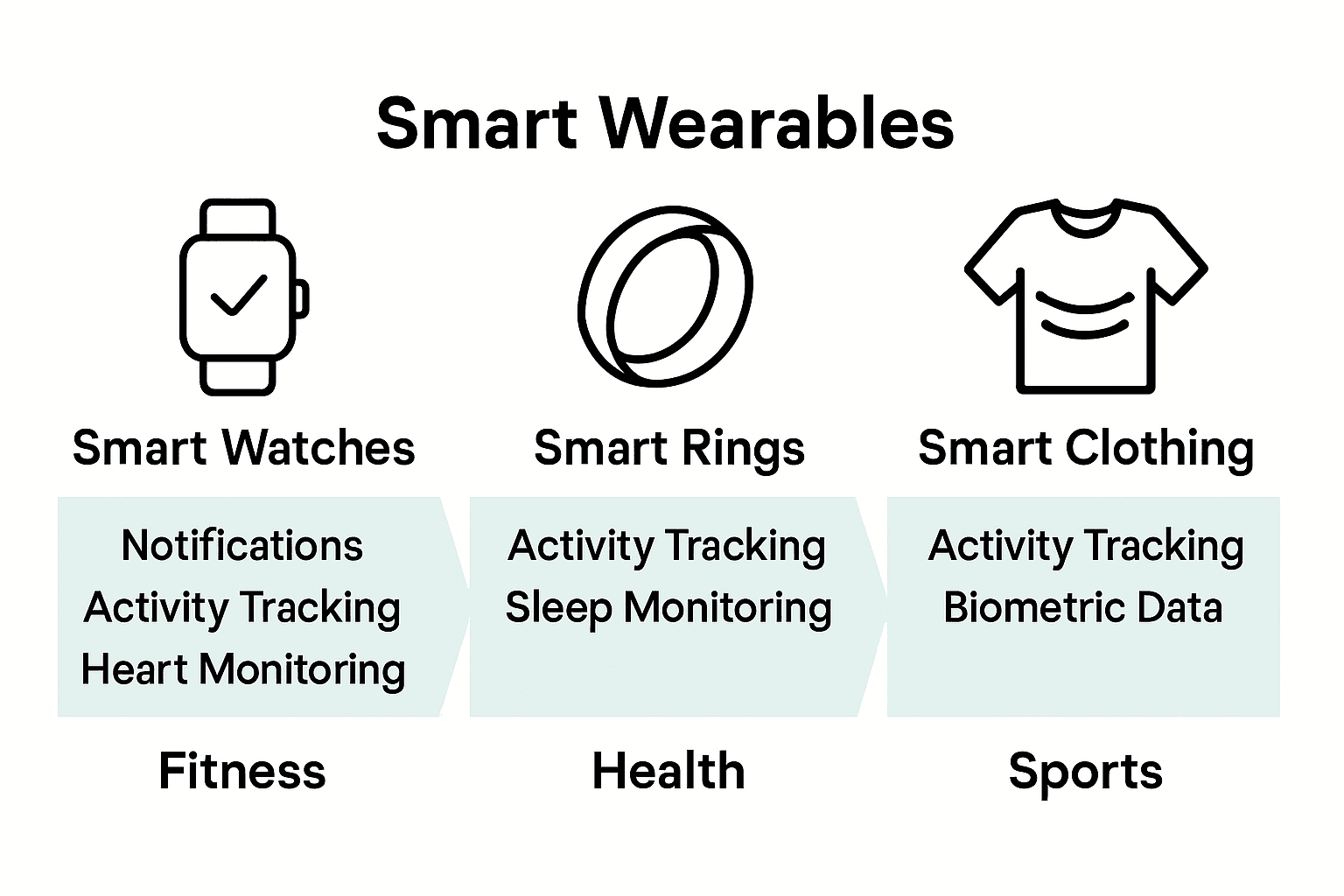Blog sidebar
Category
Recent Posts
- Dec 27, 2025
- Dec 24, 2025
- Dec 21, 2025
- Dec 19, 2025

The Essential Guide to Why Use Smart Wearables
Contents
Over 1.1 billion smart wearables are in use worldwide, reflecting a rapid shift in how people monitor health and manage daily life. These devices have moved far beyond tracking steps or counting calories. They help users understand vital signs, stay connected, and gain insights that once seemed possible only in science fiction. As smart wearables continue to transform routines and wellness, understanding what they are and how they work is more relevant than ever.
Key Takeaways
| Point | Details |
|---|---|
| Smart Wearables Integration | Smart wearables are advanced devices that seamlessly collect and analyze personal health and activity data, driving improved lifestyle choices and health management. |
| Diverse Device Types | Popular types include smart watches, rings, and clothing, each with unique features catering to health monitoring, fitness tracking, and daily convenience. |
| Health Benefits | These devices promote continuous health monitoring, personalized feedback, and early detection of health issues, enhancing overall wellness. |
| Privacy and Security Concerns | Users should be aware of data vulnerabilities and the need for robust privacy measures when integrating smart wearables into their lives. |
What Are Smart Wearables And How They Work
Smart wearables represent the cutting edge of personal technology, transforming how we track, understand, and interact with our own bodies and environments. These intelligent devices are essentially miniature computers embedded into items we wear, ranging from watches and rings to clothing and accessories, designed to collect and analyse personal data seamlessly.
According to research from MDPI Sensors Journal, these devices capture physiological and activity data through sophisticated sensors, transmitting information using wireless technologies like Bluetooth Low Energy (BLE), Zigbee, or Wi-Fi. The captured data is then processed in cloud systems, providing users with meaningful insights about their health, fitness, and daily activities.
Key characteristics of smart wearables include:
- Continuous biometric sensing capabilities
- Lightweight and comfortable design
- Wireless data transmission
- Real-time activity and health monitoring
- Personalised feedback and recommendations
Research from Smart Wearables Archive highlights that modern devices like smart rings exemplify this technology, combining comfort with advanced computing capabilities. These devices don’t just passively collect data but can also provide interactive input and output, creating a dynamic personal technology ecosystem that adapts to individual user needs and preferences.
Popular Types Of Smart Wearable Devices
Smart wearable technology has exploded with innovative devices designed to seamlessly integrate technology into our daily lives. From fitness trackers to advanced health monitors, these devices come in various forms, each offering unique capabilities that transform how we interact with personal technology.
Smart watches remain the most recognisable wearable, offering features like health tracking, notifications, and communication capabilities. Fitness enthusiasts particularly appreciate models that monitor heart rate, track steps, and provide workout insights. Check out our guide on affordable smart watches that do it all to explore the latest options available.
According to research, smart rings represent a fascinating category of wearables with compact yet powerful functionality. As documented by Wikipedia, these devices offer impressive features like:
- Mobile payments
- Access control systems
- Gesture control interfaces
- Activity tracking capabilities
- Near Field Communication (NFC) technology
Another groundbreaking innovation comes from smart clothing, exemplified by the Hexoskin smart shirt. Research indicates these intelligent garments can embed physiological sensors directly into textiles, enabling comprehensive health monitoring. The Hexoskin shirt specifically can track sophisticated metrics including:
- Electrocardiogram (EKG) readings
- Heart rate variability
- Breathing rate
- Detailed actigraphy data
These advanced wearables communicate via Bluetooth, providing real-time remote monitoring that was unimaginable just a decade ago. Whether you’re a fitness buff, health-conscious individual, or tech enthusiast, there’s a smart wearable designed to enhance your lifestyle and provide unprecedented personal insights.

Here’s a comparison of popular smart wearable device types and their key features:

| Device Type | Typical Features | Popular Use Cases |
|---|---|---|
| Smart Watch | Notifications Health tracking Communication |
Fitness Everyday productivity |
| Smart Ring | Activity tracking Mobile payments NFC |
Contactless payment Access |
| Smart Clothing | Heart & breathing rate EKG tracking Comfort |
Health monitoring Sports |
Top Benefits Of Smart Wearables For Everyday Life
Smart wearables have revolutionised personal health and technology management, offering unprecedented insights into our daily lives and well-being. These intelligent devices go far beyond simple tracking, transforming how we understand and interact with our personal health, fitness, and lifestyle choices. Learn more about the future of wearable tech, where innovation meets personal empowerment.
According to research from GAIN Health, wearables play a crucial role in promoting healthier lifestyles and driving long-term behavioral changes. By raising body awareness, these devices contribute significantly to potential healthy aging strategies. The key benefits include:
- Continuous health monitoring
- Personalised fitness tracking
- Early detection of potential health issues
- Motivation for physical activity
- Stress management and mental wellness support
Beyond health tracking, smart wearables offer practical advantages in daily life. They seamlessly integrate technology into our routines, providing instant notifications, communication tools, and personalised recommendations.
Whether you’re a fitness enthusiast, a busy professional, or someone looking to improve overall wellness, these devices adapt to your unique lifestyle, offering real-time insights and actionable data that can help you make more informed decisions about your health and well-being.
However, it’s important to note that while these devices offer immense potential, challenges remain in areas like data protection, accuracy, and user acceptance. As technology continues to evolve, smart wearables are becoming increasingly sophisticated, promising even more comprehensive and personalised health management solutions in the future.
Real-Life Applications Across Health, Fitness, And Home
Smart wearables have transcended mere technological novelty, becoming essential tools that integrate seamlessly into our health, fitness, and home environments. These intelligent devices are revolutionising how we monitor personal wellness, manage chronic conditions, and interact with our living spaces. Explore the best home fitness equipment to complement your wearable technology.
According to research from the National Center for Biotechnology Information, smartwatches are playing a critical role in healthcare accessibility. They enable health data monitoring for underserved and remote populations, supporting emergency services and chronic disease management. This technological breakthrough reduces the need for frequent in-person medical visits and empowers patient-centered care.
Key applications of smart wearables across different domains include:
- Health Monitoring
- Continuous vital sign tracking
- Stress level assessment
- Blood pressure monitoring
- Fitness Management
- Real-time workout performance tracking
- Personalised exercise recommendations
- Activity and calorie expenditure analysis
- Home Integration
- Voice-based assistance
- Location tracking for elderly care
- Environmental health monitoring
Research from Advanced Wearable Systems highlights an innovative smart home health monitoring system that demonstrates the potential of wearable technology. This system uses wristband sensors to monitor stress, blood pressure, and location, integrating voice-based assistance to provide personalised long-term care, especially for elderly individuals. By bridging technology and personal wellness, smart wearables are transforming how we understand and manage our health across various life domains.
Privacy, Security Risks, And Cost Considerations
Smart wearables offer incredible technological benefits, but they also raise critical questions about personal data protection, security vulnerabilities, and financial investment. Consumers must carefully weigh the advantages against potential risks to make informed decisions about integrating these devices into their lives. Explore our guide on smart technology safety.
Research from Springer’s Security Analysis highlights significant security vulnerabilities, particularly in Bluetooth Low Energy (BLE) data transmission. The study reveals specific concerns for vulnerable populations like minors, emphasising the need for enhanced manufacturer transparency and robust protection mechanisms.
Key privacy and security considerations include:
- Data transmission vulnerabilities
- Potential personal information exposure
- Bluetooth and wireless communication risks
- Unintended location tracking
- Potential device hacking opportunities
According to GAIN Health Research, while wearables offer substantial health benefits, they come with important caveats:
- Measurement accuracy varies between devices
- Data should not replace professional medical advice
- User acceptance remains a significant challenge
- Comprehensive data interpretation requires expertise
Cost remains another critical factor for potential users. Smart wearables range from affordable fitness trackers to high-end medical-grade devices, with prices typically spanning £50 to £500. Consumers should consider long-term value, including device durability, update frequency, and potential health insights gained, rather than focusing solely on upfront expenses. Ultimately, selecting the right smart wearable requires balancing technological capabilities, personal privacy preferences, and individual budget constraints.
Elevate Your Lifestyle with Smart Wearables From Stomart
Are you overwhelmed by the challenge of staying healthy, tracking your fitness, or keeping your daily routines organised? As covered in this guide, issues like reliable health monitoring, maintaining motivation, or even concerns about privacy can make it hard to take control of your wellbeing. Smart wearables provide real-time health insights, seamless tracking, and practical solutions that fit easily into your day to day life. But finding the right device at the right price without compromising on technology or ease of use is often a struggle.
Bring the benefits highlighted in our article directly into your home with Stomart.co.uk. Explore our curated selection of personal wellness gadgets and essential tech accessories designed to support your health goals and enrich your lifestyle. Discover products crafted for comfort and convenience, and unlock exclusive offers on the best in smart technology. Take the first step towards a healthier, more connected routine by browsing Stomart’s trending personal wellness collection today. Your future of smarter living starts now—visit our site and experience easy, secure shopping with fast delivery on your next smart wearable solution.
Frequently Asked Questions
What are smart wearables and how do they work?
Smart wearables are advanced devices that integrate technology into clothing and accessories to monitor personal health and activity. They use sensors to collect data like heart rate and activity levels, which is transmitted wirelessly for analysis, providing users with insights into their health.
What are the different types of smart wearable devices?
Common types of smart wearables include smart watches, smart rings, and smart clothing. Each category offers distinct features: smart watches are known for notifications and health tracking, smart rings offer compact functionality like mobile payments, and smart clothing integrates sensors for comprehensive health monitoring.
How can smart wearables benefit my daily life?
Smart wearables can promote healthy lifestyles by providing continuous health monitoring, personalized fitness tracking, and early detection of potential health issues. They also offer practical advantages, such as instant notifications and personalized recommendations to help you make informed lifestyle choices.
Are there any security risks associated with smart wearables?
Yes, smart wearables can pose privacy and security risks, particularly regarding data transmission vulnerabilities and the potential for personal information exposure. Users should be aware of these risks and consider the accuracy of device measurements, as well as the importance of not relying solely on device data for medical advice.
Recommended
- The Future of Wearable Tech: Gadgets You’ll Actually Use - STOMART.CO.UK
- Bluetooth Call Smartwatch - STOMART.CO.UK
- Affordable Smart Watches That Do It All - STOMART.CO.UK
- Top Fitness Gadgets That Track Your Progress - STOMART.CO.UK
- Dog Alert Device Usage: Practical Guide for Owners and Handlers 2025 – iPupPee
- Remote Monitoring in Healthcare: 2025 Trends and Best Practices
Share
YOU MAY ALSO LIKE
- Dec 27, 2025
- Dec 24, 2025
- Dec 21, 2025
- Dec 19, 2025
- Dec 17, 2025
- Dec 16, 2025
- Dec 15, 2025
- Dec 15, 2025
- Dec 15, 2025
- Dec 11, 2025
- Dec 11, 2025
- Dec 08, 2025
- Dec 05, 2025
- Dec 05, 2025
- Dec 02, 2025
- Dec 01, 2025
- Dec 01, 2025
- Nov 30, 2025
- Nov 30, 2025
- Nov 29, 2025
- Nov 25, 2025
- Nov 24, 2025
- Nov 23, 2025
- Nov 22, 2025
Category
Recent Posts
- Dec 27, 2025
- Dec 24, 2025
- Dec 21, 2025
- Dec 19, 2025



















































